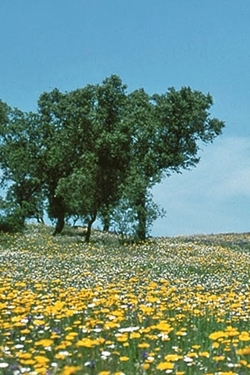Key points
- Bird diversity on farmland in southern Portugal was studied and correlated with the type of crops grown, and the habitat in the non-cropped, natural and semi-natural areas, as well as the diversity of crops and the arrangement of the landscape.
- The most important factor for bird abundance was the type of crop grown.
- The presence of natural habitat was also important.
- The diversity of crops, and the complexity of the landscape had a weak effect.
- To maximise biodiversity, it is important to consider adjusting farming practices to include wildlife-friendly crops.
Background
 Biodiversity on farmland has dropped severely in recent decades, with changing farming practices affecting many species. Conservation on farmland is essential to try to halt these declines and support species recoveries.
Biodiversity on farmland has dropped severely in recent decades, with changing farming practices affecting many species. Conservation on farmland is essential to try to halt these declines and support species recoveries.
One possibility to support biodiversity is to alter the crops that are grown towards more “biodiversity friendly” crops. This comes with an associated loss of profits, but other approaches to support farmland birds have been proposed, including for example altering how crops are arranged within the landscape, whilst not adjusting the overall crops that are present.
This study examines the importance for farmland bird diversity of:
- Which crops are grown
- The number of different crops that are grown
- The arrangement of these crops
What they did
The scientists conducted a large study in southern Portugal over two periods of time, surveying birds and recording farming methods during both 1995-1997 and 2010-2012. The first of these was before reform of the Common Agricultural Policy, and the second was after, so there were changes in farming practices between the two periods of time. This allowed a study of what may have affected bird species.
They looked at several important characteristics about both the cropped area of the landscape (the “productive component”), and also the uncultivated areas of woodland, hedgerows, streams etc, (called the “natural component”). These are described below:
“Compositional heterogeneity” – This can also be called diversity, and means the mixture of different types of crop that there are. If an area has only two types of use – pasture and arable crop, for example – then that area has fewer bird species than an area which might contain pasture, arable crop, permanent crop and annual dry crops. Regardless of what the crop is, the diversity score tells us how many different kinds there are.
An example of higher diversity is shown below:

“Configurational heterogeneity” – This refers to how complex the layout of an area is. There may be the same number of different kinds of crop, but if they are in a more complicated patchwork arrangement, rather than large blocks, the complexity of the area is higher and there are more boundaries between them, as shown below:

These three factors were recorded over both study periods. This information was then analysed along with the results from the bird surveys, to determine which factors had the most influence on bird diversity – for all birds together, and separately for woodland species, farmland species and species of the steppe.
What they found
- The number of bird species of all types increased between 1995-97 and 2010-12.
- The majority of the landscape was used for production, with only a small proportion being natural.
- The most important factor determining the number of bird species characteristic of steppe habitat in the study area was the kind of crop that was grown in the area used for farming – the production component.
- Both farmland and steppe species were influenced positively by the heterogeneity of natural habitats
- The characteristics of the cropped area (production section) tended to influence the farmland and steppe species, whereas the natural component tended to influence the woodland and shrubland species.
- Increasing the mix of the other two factors – either the number of crops grown in an area (diversity), or the complexity of their layout (spatial complexity) had a minor positive effect on bird biodiversity.
What does this mean?
These results suggest that the type of crop grown is very important when managing farmland for conservation. A diverse mix of crops and a complex mix across the landscape can also contribute to bird diversity. Natural areas are important in the landscape, and some of these, for example streams, had particular impact on bird species.
Read the original abstract
Santana, J., Reino, L., Stoate, C., Moreira, F., Ribeiro, P.F., Santos, J.L., Rotenberry, J.T., & Beja, P. (2017). Combined effects of landscape composition and heterogeneity on farmland avian diversity. Ecology and Evolution, 7: 1212-1223.
 Does this page interest you?
Does this page interest you?
If the answer is yes, join over 25,000 others and sign up for our FREE weekly newsletter to get all the latest GWCT research news, event invites and offers delivered straight to your inbox.
Sign up FREE >